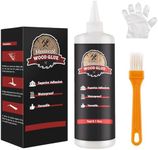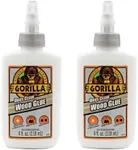Buying Guide for the Best Wood Glue For Chairs
Choosing the right wood glue for chairs is crucial to ensure the durability and stability of your furniture. Wood glue is used to bond wooden parts together, and the right type can make a significant difference in the strength and longevity of the joints. When selecting wood glue, consider the type of wood, the conditions the chair will be exposed to, and the specific requirements of your project. Here are some key specifications to consider when choosing wood glue for chairs.Type of GlueThere are several types of wood glue, including PVA (polyvinyl acetate), epoxy, polyurethane, and hide glue. PVA glue is the most common and is suitable for most indoor furniture projects. Epoxy is very strong and water-resistant, making it ideal for outdoor furniture or chairs that will be exposed to moisture. Polyurethane glue is also water-resistant and works well with oily or dense woods. Hide glue is traditional and reversible, making it a good choice for antique furniture restoration. Choose the type of glue based on the specific needs of your chair project and the environment it will be used in.
Open TimeOpen time refers to the amount of time you have to work with the glue before it starts to set. This is important because it determines how much time you have to position and clamp the pieces together. Short open times (5-10 minutes) are suitable for quick projects or when you have all pieces ready to assemble. Longer open times (20-30 minutes) are better for complex assemblies or when you need more time to adjust the pieces. Consider the complexity of your chair project and your working speed when choosing a glue with the appropriate open time.
Drying TimeDrying time is the period it takes for the glue to fully cure and reach its maximum strength. This can range from a few hours to a full day. Faster drying times (1-2 hours) are convenient for quick repairs or when you need to use the chair soon after gluing. Longer drying times (12-24 hours) are generally stronger and more durable, making them suitable for high-stress joints. Think about how soon you need the chair to be ready for use and the importance of joint strength when selecting a glue with the right drying time.
StrengthThe strength of the glue is crucial for ensuring the joints can withstand the weight and stress of regular use. Glues are often rated by their tensile strength, which measures how much force they can withstand before breaking. High-strength glues are essential for load-bearing joints, such as those in chair legs and arms. For decorative or non-load-bearing joints, a medium-strength glue may suffice. Assess the structural requirements of your chair and choose a glue with the appropriate strength to ensure durability.
Water ResistanceWater resistance is important if the chair will be exposed to moisture, such as in outdoor settings or humid environments. Glues are typically rated as interior (not water-resistant), exterior (water-resistant), or waterproof. Interior glues are suitable for indoor furniture that won't be exposed to moisture. Exterior glues can handle occasional moisture and are good for outdoor furniture. Waterproof glues are the best choice for furniture that will be regularly exposed to water or high humidity. Consider where the chair will be used and choose a glue with the appropriate level of water resistance.
ColorThe color of the glue can affect the final appearance of the chair, especially if the glue line is visible. Some glues dry clear, while others dry to a yellow or brown color. Clear-drying glues are ideal for light-colored woods or when you want the glue line to be less noticeable. Yellow or brown glues can blend better with darker woods. Think about the color of the wood and the visibility of the glue line when selecting a glue with the right color for your project.




















